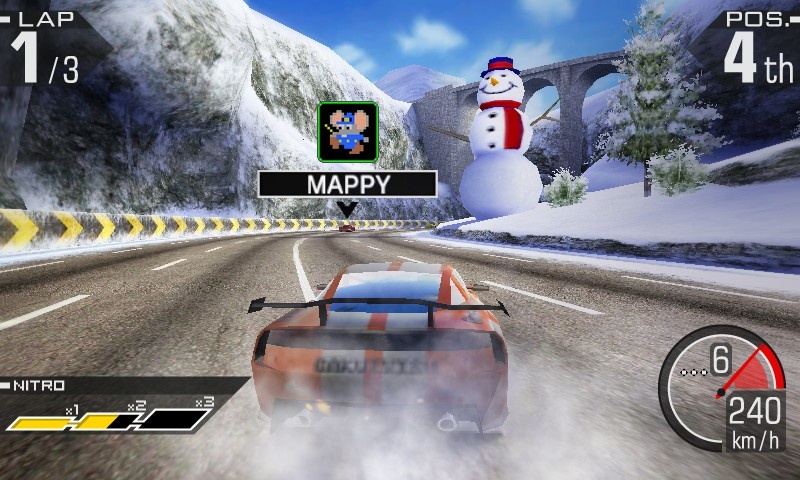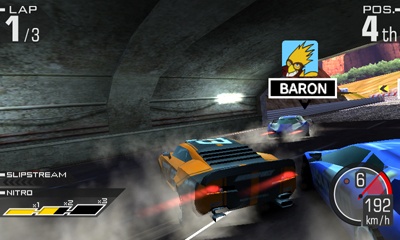While Ridge Racer 3D brings little in the way of new features or ideas to the series--relying largely on Ridge Racer 7's feature set--there's still fun to be had. Races are fast, twitchy experiences, thanks to good circuit design and visuals that give a real sense of speed. The arcade-style handling is as unrealistic as ever; it lets you spend most of your time careering around the track sideways, skidding around corners to perform impressively long drifts. Tight controls and an impressive array of customisable cars make mastering those drifts fun, and each car's unique handling characteristics add variety too. It's a shame, then, that there aren't a whole lot of tracks to drive those cars on, nor is there any online multiplayer to spice things up.
If you've never played a Ridge Racer game, picking it up for the first time can be a little confusing, particularly as there's little in the way of a tutorial. Even for an arcade racer, handling is spectacularly unrealistic. Cars stay glued to the asphalt at speeds upwards of 300kmh, seemingly impervious to whatever bumps and scrapes they receive from the opposition, while so much as tapping the brake to slow down for a corner lets the opposition zoom past to first place. Discover Ridge Racer's drifting mechanic, though, and everything begins to make sense. You initiate a drift by easing off the accelerator, turning into a corner, and accelerating again. Your car largely guides itself during these controlled skids--your goal being to make sure your car is pointing in the right direction when you've made it around the corner by applying subtle nudges to the steering. Alternatively, Ridge Racer 3D lets you assign drifting to a single button, which makes drifts a little easier to initiate.
Regardless of which method you choose, drifting is a lot of fun. Though your car is essentially on-rails during drifts, the nimble steering required to guide your car out of them again provides a challenge. Car choice plays an important role in this too. Cars rated as mild stick steadfastly to the road and are relatively controlled around corners but aren't fast. Standard cars have decreased grip but increased speed, while dynamic cars are the fastest but are extremely loose around the corners, making it a lot of work to get them safely out of a drift. Nitrous boosts add an element of strategy too, because they're charged during a drift. Your boost meter fills up in three stages, each stage providing successively more acceleration. They're extremely useful during straight sections of a course but can also be used for a huge speed boost when coming out of drifts, allowing you to overtake opponents on bends.

The slipstream mechanic from Ridge Racer 7 also makes a return. If you drive directly behind an opponent, even at a great distance, you accelerate faster and earn a greater top speed. A meter shows when you've entered a slipstream, increasing the closer you are to your opponent. By riding a slipstream until you're practically touching the back of your opponent's car, and then swinging out, you can slingshot around him for some dramatic overtaking. Using your nitrous and slipstreams effectively is key to winning races, particularly on harder circuits where aggressive opponents ram your car and use your own slipstream against you. There are other options for beating them, though, in the form of upgrades for your car. You can change the nitrous type, giving you an extra bar or one large bar that you can use at any time without filling it fully. There are also support items that provide you with precharged nitrous at the start of a race or automatic boosts off the starting line.
Upgrades and support items are paid for with points that you earn during the single-player Grand Prix mode. You start off racing in the Basic Grand Prix, which is divided into a number of different rounds, each consisting of four races against seven opponents. You have to finish within the top three for the first two races, the top two for the third race, and finish first in the last race to progress. New tracks are unlocked as you win races, though fans of the series should be familiar with them already, as many have appeared in previous games. Even if they're new to you, tracks are reused so many times in Grand Prix that they soon become repetitive, though later races do add reversed versions of the tracks for some much-needed variety. Other unlocks include new car categories, each containing more powerful cars than the last, and the advanced and expert Grand Prix modes, where you're pitted against more aggressive opponents.
Once you've unlocked a track in Grand Prix mode, you can play it again by yourself in Time Attack mode or against CPU opponents in Standard Race mode. There's also Quick Tour, which generates a mini-Grand Prix based on the amount of time you wish to play, and One-Make Race, where your CPU opponents all drive the same car as you. If you're bored with CPU opponents, you can race against up to three of your friends via local Wi-Fi Versus mode, but sadly you can't race over the Internet or via download play. There's not even an online leaderboard so you can challenge others indirectly, which significantly decreases the game's longevity. Ridge Racer 3D does implement StreetPass, though. When StreetPass is enabled, your 3DS exchanges race data with other 3DS owners nearby, allowing you to race against their times via a ghost car, gaining points if you win. It doesn't quite make up for the lack of online features, but it's a neat addition nonetheless, particularly if you live in an area with lots of 3DS owners.

Ridge Racer 3D is a handsome-looking game, if a little on the dull side. Circuits like Downtown Rave City and Rave City Riverfront look great with their bright neon lights and huge bridges, but others like Redstone Thunder Road and Shadow Caves are filled with brown textures that have been slapped onto the side of an endless stream of blocky mountain ranges. Switching on 3D livens things up; the aforementioned mountain ranges now stretch off into the distance, and huge jumps become much more exciting when you can see how far up you're about to go. A few cheap tricks are used, such as ticker tape and piles of leaves that fly at your face during a drive, but on the whole, 3D is used effectively, adding depth to circuits and giving races a real sense of speed.
Ultimately, there's little in Ridge Racer 3D that fans won't have seen before, and while the 3D is nice to look at, it's hardly enough to justify a purchase if you're looking for something different from the series. The idiosyncratic handling of the cars isn't for everybody either, but if you enjoy the unique style of racing and can live without online features, Ridge Racer 3D is a fun drive.